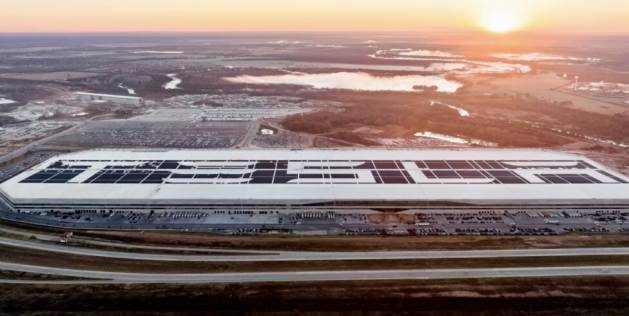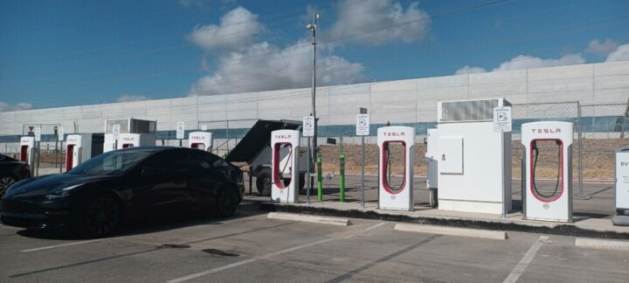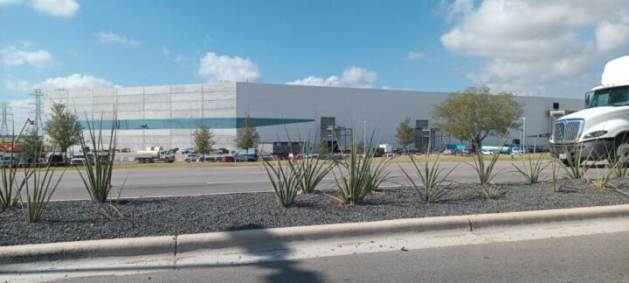The Opaque Chain of Electric Cars Assembled in Mexico

AUSTIN, Texas, US, Dec 20 (IPS) - The city of Austin, Texas, on the U.S.-Mexico border, had 945,000 residents in 2021 and on average each household owned two cars, hundreds of them electric. Among the manufacturers of these electric vehicles are companies such as the US Tesla, Ford and General Motors (GM).
From Tesla's plant in Travis County, one of the automaker's eight global facilities, there is a virtually invisible line to its future subsidiary in Santa Catarina, in the northeastern Mexican state of Nuevo Leon, two locations separated by about 600 kilometers.
The company produced the largest number of electric vehicles (EVs) and plug-in hybrids in the second quarter of 2023, followed by the Chinese company Build Your Dreams (BYD).
Tesla has attracted Mexican engineers trained in Nuevo Leon and from Austin supervises the construction of the new plant, whose investment is around 5 billion dollars.
Hundreds of these rolling steel beetles, many of them electric (even from other brands), fill the parking lot of the facility, where Tesla manufactures its Model Y and a cybertruck, and will soon make batteries and cathodes, one of its main parts and which is the electrode that transports the positive electrical charge.
In the morning hours, these vehicles crowd Tesla Street, so rechristened for obvious reasons.
The process involves an issue that is becoming more and more relevant: the transparency of the supply chain. The number of parts in an EV battery varies by model, but in total it’s less than an internal combustion unit.
But, according to specialists interviewed, this chain has different levels of transparency, depending on the company in question. U.S. and European brands are leading the way, while Chinese brands are lagging.
But under pressure from governments, non-governmental organizations and consumers, the situation is showing signs of change.
The supply chain involves the phases of extracting the raw materials for the product, processing and refining them for the preparation of the commodity materials, their coupling for use in the final good, and the end of their useful life, which includes reuse or recycling.
This scaffolding is made up of hundreds of actors, generally disconnected from each other, and involves an enormous effort to trace them and which makes it difficult to clarify who provides which component.
In the research for this report, IPS found that the EV supply chain in Mexico is opaque, which has environmental and human rights repercussions.
In 2021, during the climate summit in the Scottish city of Glasgow, Mexico assumed the voluntary goal of selling only non-polluting cars by 2035. In addition, the U.S. administration of Democrat Joe Biden wants 50% of new cars sold by 2030 to be electric.
Global Player
Yong Kwon, the non-governmental Sierra Club’s senior policy adviser, noted that the focus has traditionally been on the greenhouse gas emissions caused by the manufacture of EVs, from the extraction of the minerals needed for the production of batteries and other components to the manufacturing itself.
However, there is increasing pressure to consider other aspects, such as respect for human rights and the presence of child labour.
"We are in the early stages of understanding the full impact of the chain. We don't know which plants supply steel, for example, to the assembly plants. By having transparency about the environmental impact, you can send signals on other issues. We want to draw attention to them," he told IPS from Washington.
Mexico is the world's fourth-largest exporter of light-duty vehicles and the fifth-largest seller of auto parts, but it has yet to weigh in on the global EV market. The automotive sector has about 600 suppliers of original parts, who in turn outsource to another 600 vendors of components or basic services.
In 2021, Mexico was the sixth-largest seller of EVs, with destinations such as the United States, Belgium, and Norway, while importing a low volume of units from the United States, Germany, and China.
It also exported the equivalent of 2% of global electric batteries, while China dominated the sector, with 35%. The main destinations were the United States, Canada and France. Meanwhile, it imported 2.86% of all components, contributed by Poland, the United States and China.
The Asian powerhouse controls almost half of the EV value chain and Contemporary Amperex Technology Company Ltd. (Catl), with its parent company in that country, produces one in three batteries in the whole world.

Mass failure
The international platform Lead the Charge, made up of several environmental organizations in the United States (including the Sierra Club), virtually failed all EV producers.
Its objective is to evaluate the automotive industry on the respect for human rights of workers, communities, and Indigenous Peoples, in a sustainable way and without the consumption of fossil fuels.
This assessment is relevant for Mexico, due to its production plant link with the United States, although there is no evaluation of manufacturing in Mexico.
Ford was the highest rated in the examination, with a total score of 33%. In the area of respect for human rights and responsible sourcing, it received 51% and, on the environment, 15%.
GM scored 15 percent overall, with 25 percent on human rights and responsible sourcing and 5 percent on the environment.
Meanwhile, the platform assigned 14% to Tesla, 21% on human rights and responsible sourcing and 7% on the environment.
Another Lead the Charge’s subject was the German BMW Group, to which it gave a total score of 22%, with 26% in environmental aspects and 17% in human rights and responsible sourcing.
The group is investing about $872 million in its plant in the municipality of Villa de Reyes, in the north-central Mexican state of San Luis Potosi, which will manufacture electric models and batteries.
For Cecilia Mattea, Battery and Value Chain Policies manager at the non-governmental network European Federation for Transport and Environment (T&E), increasing transparency in value chains offers benefits to stakeholders, such as local communities affected by mining.
"Some automakers are taking significant steps to make their operations more transparent, but others are still lagging behind, especially on sustainability commitments, not to mention increasing transparency," she told IPS from Brussels.
In 2021, Ford began mapping and auditing the EV and battery supply chain to uncover the source of raw materials such as nickel, lithium, cobalt, and graphite.
In its 2022 sustainability report, Ford, whose global headquarters are located in the U.S. city of Detroit, listed 30 appraisals to its suppliers from these four chains and reviews of its nickel, lithium and cobalt due diligence management systems. But the company has not given details about these measures.
At its plant placed in the municipality of Tutltitlán, located in the central state of Mexico (adjacent to Mexico City), the U.S. multinational assembles the Mustang Mach-E electric model, aimed mainly at the U.S. market.
Customs data from Mexico and Comtrade, the United Nations' trade statistics system, reveal that Ford imports lithium-ion batteries from companies such as LG Chem and Samsung SDI, which have plants in South Korea and China.
It also acquires electronic components, such as sensors and communication systems, from Germany, the United States and China.
Meanwhile, GM is much more succinct with its information and only indicates its plans to get cobalt from the Democratic Republic of Congo through a multi-year agreement with Australian miner Glencore, as well as lithium from Argentina.
GM assembles batteries and EVs at its factory in the municipality of Ramos Arizpe, in the northern Mexican state of Coahuila, for which it imports lithium batteries from LG Chem, which has suppliers in China and Japan.
The case of Tesla is extremely relevant, due to its ambitious EV production goals, its global expansion, including its future plant in Mexico, and its dependence on China, an aspect linked to the level of transparency of its supply.
This manufacturer sources batteries mainly from Japan's Panasonic and China's Catl. In addition, it uses battery cells from LG Chem and BYD.
In the case of batteries, its suppliers include Catl, South Korea's LG Energy Solution, BYD, Panasonic, South Korea's SK On, Samsung SDI and China's China Aviation Lithium Battery Co. (Calb), Guoxuan High-tech Co., Sunwoda Electronic Co. and Svolt Energy Technology Co.
Regarding raw materials, Tesla buys lithium from the US-based Albemarle Corporation, which owns a mine in Australia and a refinery in China; Livent, also from the United States; and China's Ganfeng Lithium Co. and Yahua Industrial Group.
It also purchases cobalt and nickel from China's CNGR Advanced Material Co. and Huayou, which mines cobalt from Congo, the same case as Glencore Kamoto Copper Company, which owns a cobalt mine in that African nation.
Japan's Nikkei news agency concluded that nearly 40 percent of the suppliers of materials used in Tesla's EV batteries are Chinese companies, accounting for 39 percent of the 61 corporations in the battery segment. The report identified more than 13 428 companies that would supply components to Tesla.
China accounted for 40% of the 42 non-ferrous metal smelting companies, excluding aluminum.
These data are relevant for the future plant in Nuevo León, as the same value chain could be repeated.
For Isabel Studer, an academic at the Riverside School of Public Policy at the University of California, the greater participation of the United States and the European Union (EU) means that issues such as human rights and the environment become more relevant.
"There is more robust civil society and laws, and there is growing concern. Critical minerals are sourced from conflict countries and that makes it difficult to have traceability and respect for human rights. As the U.S. develops this industry further, there is going to be more demand for these minerals to come from sources that have no impacts", she told IPS from Mexico City.
But the expert warned that such a large demand causes a lack of incentives for manufacturers or refiners to check whether the mining companies are complying with basic standards and asked about the timeframe for these requirements to have a positive impact on the supply chain.
GM and Tesla did not respond to IPS's inquiry, while Ford de Mexico said it did not have a spokesperson available on these issues.
Mining Fever
Although the electrification of as many activities as possible is desirable to abandon fossil fuel consumption and reduce polluting emissions, the deployment of electric cars poses major challenges.
In his 2022 book Volt Rush, journalist Henry Sanderson recounts that Elon Musk, Tesla’s flamboyant owner, acknowledged that his firm would need to increase battery production a hundredfold by 2030, enough to make around twenty million cars a year.
But these goals would require four times the amount of lithium the world currently produces. The Paris-based International Energy Agency, which groups the largest consumers of hydrocarbons, predicted that demand for this mineral would grow thirtyfold by 2030 and more than 100 times by 2050.
An EV contains 83 kilograms of copper, triple the amount of a conventional vehicle, as it is present in the battery, electric motor, inverter, and wiring.
The requirement for copper and nickel would grow two- to three-fold to meet the needs of clean cars and clean power grids by 2050, posing environmental and social risks, according to the "2050 Net Zero Roadmap for Copper and Nickel Value Chains."
If each of the 1 billion cars currently on the road were replaced by a Tesla model, the demand for cobalt would be equivalent to fourteen million tons, twice the size of the world's identified reserves.
For this reason, the electrification of public and private transport already has serious climate, environmental and social impacts, as evidenced by well-documented cases in Congo (cobalt), Argentina (lithium) and Indonesia (nickel), to mention just a few cases.

Make-up or depth?
Faced with the maze of supply chains and the impacts observed, several initiatives are emerging to promote transparency and accountability.
In Germany, the law on corporate due diligence obligations, aimed at the prevention of human rights violations in supply chains –applicable to the automotive sector– and specifying obligations to address environmental and human rights risks, came into force in January.
In addition, the implementation of the so-called "battery passport", developed by the Global Battery Alliance (GBA), the multi-stakeholder entity that emerged in 2017 to establish a sustainable battery value chain by 2030, is underway.
This instrument, backed by companies such as BMW, Calt, LG Chem, Samsung SDI, Sunwoda and Tesla, will be a mandatory requirement in the EU in 2026 and it is not ruled out that other jurisdictions will adopt it as well.
The passport will provide transparency on battery practices and impact across the value chain to all relevant stakeholders, create a framework for comparing those devices based on the criteria for a sustainable and responsible battery, as well as validate and track progress towards sustainable, responsible, and resource-efficient components.
Three pilots carried out by Germany's Audi and Tesla reveal the vicissitudes of the initiative, as they were only able to track a portion of the lithium and cobalt used in the battery, thus showing gaps in the monitoring.
In addition, the EU is also debating the draft Law on Critical Raw Materials, which aims to strengthen the security of the supply of these ingredients, by defining 34 fundamental elements and 17 strategic ones, as well as actions for regional supply, national research, and diversification of imports.
In the United States, the Inflation Reduction Act of 2022 incentivizes the purchase of EVs under the condition that at least half of the battery's components are manufactured in North America and 40% of the minerals used in them comes from domestic sources or countries with which the United States has trade agreements –not China or Russia–. Both percentages will rise from 2029.
For these incentives, cheap labor (compared to the United States), lax permits and logistics route, Tesla chose Nuevo León for its new plant, with capacity for one million EVs and which will be in operation in 2026.
A time that is considered very slow because in Shanghai (China), the construction of a similar plant took 10 months and in Austin, just over a year, plus the expansion process throughout 2023.
But one unknown is the execution of these frameworks, given the magnitude of the challenge.
Although Studer, from the University of California, questioned the record of the United States and the EU in the traceability of products, she considered that they can now exert greater influence.
The U.S. "could have a greater impact in introducing traceability standards, to ensure that the chain has better practices. There are going to be certifications (of batteries). To the extent that it imposes these standards, exporters must comply with them. There should be diversification of supply, because as long as China has a virtual monopoly in the stages, it's not going to happen overnight", she said.
According to the Sierra Club's Kwon, the achievement of the standards is linked to improving authorities’ capacities in the United States, Mexico or the EU.
"We hope that international markets will provide tools for producers to comply with the requirements, for Chinese companies, for example, to disclose aspects of the chain. The emerging requirements will be chaotic at first, but they will push players to be more transparent. They can have a positive impact," he said.
T&E's Mattea recommended that Mexico and other countries also introduce oversight mechanisms.
“With the EU regulation on batteries, a big step forward has been taken to ensure that value chains are more transparent thanks to the provisions on carbon footprint, due diligence and battery passporting. In the coming years, these rules will be mandatory for batteries introduced on the market" in the EU, she stressed.
In 2023 third quarter, Tesla produced 430 488 vehicles, down 10% from the second-quarter results (479,700).
But as the EVs craze sweeps across North America, its demand for materials, whose origin remains shrouded in opaque layers, is increasing.
This article was produced by IPS with support from the Heinrich Böll Foundation.
© Inter Press Service (2023) — All Rights Reserved. Original source: Inter Press Service
 Global Issues
Global Issues